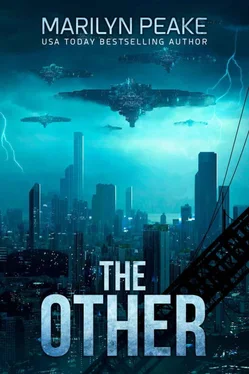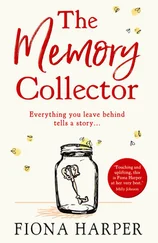TTA put me through rigorous virtual reality training in which I relived this moment over and over again, and then relived it once more in a modified scene. I watched myself refill his water pitcher and chat with him as the other nurse hung the bag filled with poisonous liquid and started the drip. I watched my father’s body tremble and stiffen in a series of seizures. I watched him die within the large black contact lenses that obscured the rest of the world and made this my only reality. I was monitored the entire time. If I took off the lenses or ordered the program to stop running inside them, I would never become a time traveler. I had to pass this test.
The final test was going back in time to that same moment with a virtual reality headset over my face, the split-screen type that allows a doctor to see reality in one section and medical information in another, so that my father wouldn’t recognize me. I was to take his vital signs through medical instruments in the headset while the nurse hung the bag and started the drip. I was to say nothing unless asked a question. I was to change nothing in that instance of time. I was to leave the room shortly after my dad began seizuring. I was in no way allowed to help or report the problem to hospital personnel.
After surviving the incident and returning to the present time, I was debriefed. And then I was treated to the ritual that made all of this easier: two solid days of raucous partying and drinking with fellow trainees. Everyone got four days off following any of our Time Travel Missions: two for partying, two for recovering. It was, I believe, a ritual for reintegrating us back into our present time and having those of us who would be traveling through time on a regular basis bond as a group. Once we became full-fledged time travelers, we’d have clubs for that. It was important for us to realize how much we would need those and how much we should turn to them for support.
After I completed my training as a time traveler on both the Anthropology and Medical teams, I received my first real mission. Training started with a series of classes. The first explained the goal of the mission.
I woke up early, showered and dressed. Looking in the mirror, I liked what I saw. My skin had a healthy green color, none of the gray tinge I’d noticed after my final training mission. The luster had returned to my eyes, which were now bright green. The top of my head was green and smooth, no longer riddled with the rash I’d developed from the neoskin helmet. Next mission, I’d be wearing one of the older models, since I seemed to be allergic to the new ones.
Walking across the TTA grounds, I thought how lucky I was. This place was beautiful and uplifting. Trees towered over white concrete buildings. Flowers in a wide variety of colors filled numerous gardens. Fountains tossed water up into the air and statues stood in the midst of them. A rich forest completely surrounded the campus, bathing it in the perfume of trees. Food was plentiful here, as were vitamins and other health enhancements. The latest in medical advancements and human-machine interfaces were available to us. Our teachers and trainers were all highly qualified.
I had started thinking about whether or not I’d like to get an interface. My best friend, a time traveler in the History division, had recently had a chip implanted in her brain that would allow her to see historical events unfold as she read about them. It was a step beyond the VR eyesets or contact lenses, more immersive.
I passed a few mechanical engineers with robotic arms that allowed them to work more efficiently on the time travel pods and the TTA’s infrastructure. One bowed their head to say hello.
When I finally arrived at the instructional building, I sighed with happiness. Looking up at the tall white building in the shadow of living, breathing trees, sunlight forming a sparkling pool on the ground in front of it, I thought how long my journey had been to this point where I’d be given an actual mission.
I stepped from the quiet campus into a hallway bustling with recent graduates, everyone on their way to find out where they’d be going and the purpose of their assignment.
I found my classroom and got seated just a few minutes before the instructor entered the room and introduced herself. She was short, had green freckles and one of the latest fashion enhancements: long blue hair implants. She looked like someone from the past when human beings still had hair. That kind of thing was totally impractical for time travelers or astronauts, but it was perfectly fine for teachers. I kind of liked the look. It was starting to grow on me.
Folding her hands, she looked around the classroom. She smiled and said, “What a fine group of time travelers we have here! Welcome to Mission Instruction. I’m Dr. Raelynn Molyneux. Here’s how you spell it…” With a printing stick in her hand, she shined her name in the air, in bold yellow letters against a black background. A few heads nodded as they took pictures with their contact lenses.
She said, “I’m going to explain your mission this way: downloads into your contact lenses followed by instruction. You’ll need to turn off all tune-out devices in your implants or contact lenses right now in order to experience the entire lesson. I’ll tell you when to turn them back on.”
We saw footage of what was happening in other parts of the world and a history lesson on scientists saving our planet through genetic manipulation in the past. There were hints that something similar would need to be done again.
I got chills partway through the lesson. What kind of manipulation were they talking about doing this time? The transition was never easy.
We saw video that had been preserved from the past: footage of raging storms and massive fires and floods. It was from the epoch labeled the Near Apocalypse by historians. To those who had lived in those times, it must have seemed like the actual Apocalypse, the coming of the end times.
A family stood in front of a burned house. The bottom section—made from wooden beams, as trees were abundant enough to do that back then—was charred and disintegrating. The interior was a pile of ash. Whatever the family had owned, all the things they had purchased and collected and treasured, had been turned to gray ash. A woman was holding up a few photographs and crying. She said to the reporter, “These are the only photos we found. All the rest were destroyed. This is all I have left of my kids’ childhoods.” The reporter asked, “Are your children OK?” Wiping tears from her face, the woman said, “Yes, thank God. Really, we’re incredibly blessed. We’re very lucky.”
From a different time and place, that sounded so odd. That woman and her family were some of the unluckiest people on the planet. Faced with overwhelming tragedy, human beings have the unique talent of only comparing it with worse tragedies, rather than with better, happier times. It’s a survival mechanism. We feel that we’re lucky, rather than cursed. We convince ourselves that our luck will only increase in the future. It helps us move forward. And for those who get stuck, we’ve invented all kinds of medicines and more recently, implants. Unfortunately, all of this dulls the potential impact that tragedy has for teaching us important lessons. The human race never seems to learn from all of its mistakes.
The reporter explained that one hundred and twelve homes in that family’s area had been destroyed by a forest fire that came down from the mountains and raged on for two weeks before firefighters got it under control. He said that luckily the fire was now completely out and families were returning to look for anything that remained of their home and belongings.
Next, there were scenes of flooded streets in what was then Miami, Florida and New York City, New York. Cars floated upside down in the middle of flooded streets. The numbers of people who drowned were staggering.
Читать дальше












